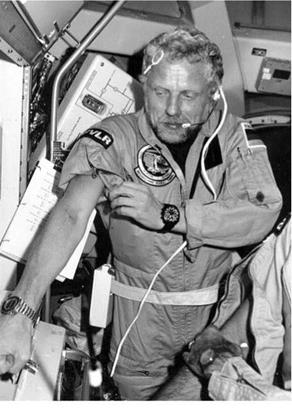STS 61-A
|
Int. Designation |
1985-104A |
|
Launched |
30 October 1985 |
|
Launch Site |
Pad 39A, Kennedy Space Center, Florida |
|
Landed |
6 November 1985 |
|
Landing Site |
Runway 17, Edwards Air Force Base, California |
|
Launch Vehicle |
OV-099 Challenger/ET-24/SRB BI-022/SSME #1 2023; |
|
#2 2020; #3 2021 |
|
|
Duration |
7 days 0 hrs 44 min 53 sec |
|
Callsign |
Challenger |
|
Objective |
Spacelab D1 research programme |
Flight Crew
HARTSFIELD, Henry Warren “Hank”, 51, USAF, commander, 3rd mission Previous missions: STS-4 (1982); STS 41-D (1984)
NAGEL, Steven Ray, 39, USAF, pilot, 2nd mission Previous mission: STS 51-D (1985)
DUNBAR, Bonnie Jean, 36, civilian, mission specialist 1
BUCHLI, James Frederick, 40, USMC, mission specialist 2, 2nd mission
Previous mission: STS 51-C (1985)
BLUFORD, Guion Stewart, 41, USAF, mission specialist 3, 2nd mission Previous mission: STS-8 (1983)
MESSERSCHMID, Ernst Willi, civilian, payload specialist 1 FURRER, Reinhard, 44, civilian, payload specialist 2 OCKELS, Wubbo, 39, civilian, payload specialist 3
Flight Log
The STS 61-A mission carrying a Spacelab Long Module was chartered by West Germany for $175 million, contributing most of the 76 scientific experiments and two payload specialists – who preferred to be called payload scientists – to the seven-day expedition. The first flight by eight crew members included five NASA astronauts, two Germans and the first space-flying Dutchman, Wubbo Ockels. Pilot Steve Nagel, former mission specialist of 51-G, was flying again after only 128 days since his previous mission, a record turnaround. The Spacelab experiment operations were controlled by the West German DFVLR centre, near Munich, via the TDRS 1 and Intelsat satellites. Lift-off came at 12:00 hrs from Pad 39A and Challenger rolled on to its launch azimuth in dramatic fashion, heading towards its 57° inclination orbit, which would have a highest point of 288 km (179 miles).
A few technical problems, including communications, RCS thruster and fuel cell anomalies, delayed the entry into Spacelab by over three hours, but soon a 24-hour
|
Payload Specialist Reinhard Furrer participates in medical experiments during Spacelab D1 |
round-the-clock regime of experimental work began, with the crew split into two shifts. They were aided when required by commander Hank Hartsfield and payload specialist Ockels, who overworked early in the mission and was ordered to rest. A unique experiment was the Space Sled, which was designed to investigate the reactions and adaptation of the human balance and orientation functions. It was moved backwards and forwards along a 7 m (23 ft) long track in the module. The Spacelab D1 programme included experiments in basic and applied microgravity research in materials science, life sciences and technology, communications and navigation.
Another first was achieved at the end of the 7 day 0 hour 44 minute 51 second mission, on runway 17 at Edwards Air Force Base, when Hartsfield conducted a computer-controlled nosewheel steering test, deliberately steering up to 10 m (33 ft) off the centre line, to gain data on ways of eliminating excessive brake and tyre wear, such as that suffered by Discovery at the end of the 51-D Kennedy landing the previous April. The Spacelab D1 mission was considered a great success, so much so that West Germany booked a repeat mission for five years time (which actually flew eight years later).
Milestones
112th manned space flight
53rd US manned space flight
22nd Shuttle flight
9th flight of Challenger
3rd Spacelab Long Module mission
1st flight with eight crew members
1st flight by a Dutchman
1st commercially leased manned space flight
1st flight by two West Germans
1st US flight to be controlled outside the USA











